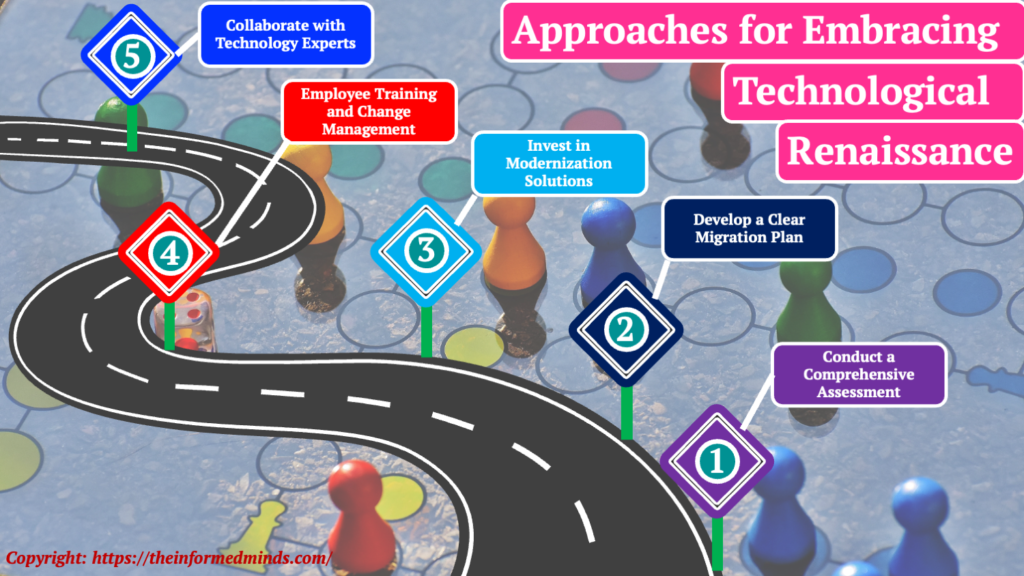To Share is to Show You Care!
In the fast-paced realm of technology, businesses are often confronted with the challenges of dealing with outdated legacy software systems. The year 2023 calls for a technological renaissance, and in this blog post, we’ll explore the best strategies to rescue your business from the chaos of legacy software. Get ready to revamp your systems and embrace a future-ready approach!
1. Understanding the Legacy Software Challenge
Legacy software can be a significant roadblock for businesses looking to stay competitive in today’s digital landscape. These outdated systems often hinder efficiency, limit innovation, and pose security risks. Before diving into solutions, let’s identify the key issues:
1.1 Compatibility Issues

Legacy software is often designed to operate in specific environments and may not seamlessly integrate with modern applications and systems. Compatibility issues arise when attempting to connect legacy software with newer technologies or when trying to establish interoperability between different software components. This can result in data transfer errors, functionality issues, and an overall lack of synergy between the legacy system and the rest of the technological ecosystem.
- Operational Inefficiencies: Compatibility issues can lead to disruptions in day-to-day operations as employees struggle to work with disparate systems.
- Data Integrity Concerns: Transferring data between incompatible systems can compromise data integrity, leading to errors and inaccuracies.
- Increased Costs: Resolving compatibility issues often requires additional resources and may incur unexpected costs.
1.2 Security Concerns
Legacy software, being outdated, may lack the robust security features and updates present in modern software. As technology evolves, so do the methods used by cybercriminals to exploit vulnerabilities. Legacy systems become more susceptible to security breaches, putting sensitive business data at risk.

- Data Breaches: Outdated security measures make it easier for malicious actors to gain unauthorized access to sensitive information.
- Regulatory Compliance Risks: Failure to meet modern security standards can result in non-compliance with industry regulations, leading to legal consequences.
- Reputation Damage: A security breach can severely damage a company’s reputation, eroding customer trust and confidence.
1.3 Limited Scalability

Legacy systems are often rigid and not designed to accommodate the scalability requirements of a growing business. As companies expand, legacy software may struggle to handle increased workloads, leading to performance bottlenecks and decreased efficiency.
- Reduced Performance: Inability to scale can result in slower response times and decreased system performance during peak usage.
- Impaired Business Agility: Limited scalability hampers the ability to adapt quickly to changing market conditions and customer demands.
- Increased Maintenance Costs: As demand grows, the need for constant maintenance and workarounds can escalate, driving up operational expenses.
Understanding these challenges is crucial for businesses aiming to address legacy software issues effectively. By identifying and comprehending these obstacles, organizations can develop targeted strategies to mitigate their impact and pave the way for a successful transition to modern, future-ready technologies.
2. The Emotional Toll of Technological Stagnation
“The pain of staying the same must outweigh the fear of change. – Tony Robbins“

3. Strategies for a Technological Renaissance

3.1 Conduct a Comprehensive Assessment
Before initiating any changes, it’s crucial to conduct a thorough evaluation of existing systems. Identify all legacy software in use, understand their functionalities, and assess their impact on current business operations. This assessment should include an analysis of compatibility issues, security vulnerabilities, and scalability limitations.
Importance
- Provides a clear understanding of the scope and scale of the technological challenge.
- Informs decision-making by identifying high-priority areas for improvement.
- Helps in creating a roadmap for the subsequent steps in the transformation process.
3.2 Develop a Clear Migration Plan
Based on the assessment, create a detailed plan for migrating from legacy systems to modern solutions. Prioritize the systems that require immediate attention, and establish a timeline for the migration process. A phased approach can minimize disruptions to regular business operations.
Importance
- Enables a systematic and organized transition, reducing the risk of errors and downtime.
- Allows for a gradual adaptation, making it easier for employees to adjust to the changes.
- Provides a framework for tracking progress and ensuring that deadlines are met.
3.3 Invest in Modernization Solutions
Explore modern alternatives, such as cloud-based solutions, that offer enhanced scalability, security, and flexibility. Consider modular approaches that allow for the gradual replacement or integration of components, ensuring a smoother transition from legacy systems to contemporary technologies.
Importance
- Positions the business to leverage the advantages of cutting-edge technologies.
- Enhances scalability, allowing the organization to adapt to changing demands.
- Provides a foundation for future innovations and technological advancements.
3.4 Employee Training and Change Management
Recognize that technological transformations impact not only systems but also the people using them. Implement comprehensive training programs to familiarize employees with new technologies and processes. Communicate the benefits of the technological upgrade to motivate and garner support from the workforce.
Importance
- Reduces resistance to change by ensuring that employees are well-prepared for the new systems.
- Enhances overall productivity as employees become proficient in utilizing modern tools.
- Fosters a positive and collaborative organizational culture during the transition.
3.5 Collaborate with Technology Experts
Seek guidance and support from professionals who specialize in legacy system transformations. Collaborating with experts can provide valuable insights, identify potential pitfalls, and offer solutions based on industry best practices. Leverage their expertise to navigate challenges effectively.
Importance
- Taps into specialized knowledge and experience, reducing the risk of common pitfalls.
- Accelerates the transformation process by leveraging proven methodologies.
- Ensures that the adopted solutions align with industry standards and regulations
By implementing these strategies, businesses can navigate the challenges of legacy software and pave the way for a successful technological renaissance. Each strategy plays a crucial role in addressing specific aspects of the transformation process, collectively contributing to a more resilient and future-ready technological foundation.
Conclusion
In the fast-evolving landscape of business technology, the journey from legacy software chaos to a technological renaissance demands careful consideration, strategic planning, and a commitment to change. As we conclude this exploration into rescuing your business from the clutches of outdated systems, it’s evident that the challenges posed by legacy software are not insurmountable obstacles but rather opportunities for growth and transformation.
By acknowledging the emotional toll of technological stagnation, understanding the common challenges, and implementing the outlined strategies, your business is poised for a future where innovation knows no bounds. Remember the wisdom in the words of Tony Robbins, The pain of staying the same must outweigh the fear of change. As we stand on the precipice of 2023, the decision to break free from the shackles of legacy software is a declaration of intent—a commitment to progress, efficiency, and security.
The journey ahead involves not just upgrading systems but empowering your team, fostering a culture of adaptability, and embracing the possibilities that modern technologies bring. It’s a holistic approach, and as you navigate the path to a future-ready business, each step contributes to the narrative of success. In this era of relentless technological advancement, your business has the opportunity to not only keep pace but to lead. The strategies outlined here are not mere solutions; they are keys to unlocking the full potential of your organization. So, are you ready for the transformation? The technological renaissance awaits, and it begins with the choices you make today. Seize the opportunity, embrace change, and position your business as a beacon of innovation in the ever-evolving digital landscape. The future is yours to shape.
Frequently Asked Questions
Q1: How do you handle legacy software?
A: Handling legacy software involves a systematic approach. Begin with a comprehensive assessment of the existing systems, identifying key issues such as compatibility, security, and scalability. Develop a clear migration plan, prioritizing systems that require immediate attention. Invest in modernization solutions, considering cloud-based alternatives for enhanced performance. Implement employee training and change management programs to ease the transition. Collaborate with technology experts to navigate challenges effectively and ensure a successful transformation.
Q2: What are legacy systems in technology?
A: Legacy systems in technology refer to outdated software or hardware that, while still in use, may hinder business operations due to factors like compatibility issues, security vulnerabilities, or limited scalability. These systems are often built on outdated technologies and may pose challenges for integration with modern applications.
Q3: How do I get rid of legacy systems?
A: Getting rid of legacy systems involves a strategic and phased approach. Begin by conducting a comprehensive assessment to identify the systems that need immediate attention. Develop a clear migration plan, prioritizing the replacement or upgrade of legacy systems. Invest in modernization solutions, such as cloud-based alternatives. Ensure employee training and change management to facilitate a smooth transition. Collaborate with technology experts to address challenges and guide the transformation process effectively.
Q4: What are the problems with legacy systems?
A: Common problems with legacy systems include compatibility issues, security concerns, and limited scalability. Legacy systems may struggle to integrate with modern technologies, making them prone to data breaches and reducing overall system performance. Additionally, the rigidity of legacy systems can hinder an organization’s ability to adapt to changing business needs, resulting in increased operational costs.
Q5: Why is legacy software hard to maintain?
A: Legacy software is hard to maintain due to several factors. Outdated programming languages and technologies may lack support, making it challenging to find skilled developers. Over time, the original developers may no longer be available, and documentation might be inadequate. These factors contribute to difficulties in fixing bugs, implementing updates, and ensuring the overall stability and security of the system.
Q6: What is considered legacy software?
A: Legacy software refers to outdated applications or programs that have been in use for an extended period. These systems may be built on obsolete technologies, lack modern features, and face challenges when interacting with newer software or hardware. Legacy software often requires special attention to maintain functionality and security.
Q7: What are examples of legacy technologies?
A: Examples of legacy technologies include outdated programming languages like COBOL, legacy databases such as dBASE and FoxPro, and hardware systems like older mainframes or servers. Any technology that has been surpassed by more modern and efficient alternatives can be considered legacy.
Q8: What is a legacy system management?
A: Legacy system management involves the ongoing maintenance, optimization, and eventual replacement of outdated systems within an organization. This process includes assessing the impact of legacy systems, developing strategies for migration or modernization, and ensuring that these systems align with current business needs and technological standards.
Q9: What is an example of legacy technology?
A: An example of legacy technology is the use of magnetic tape storage systems for data backup, which has largely been replaced by more advanced and efficient methods like cloud storage or solid-state drives. Another example is the continued use of outdated programming languages like Fortran in certain applications.
Q10: How do you modernize a legacy system?
A: Modernizing a legacy system involves a multi-step process. Begin with a comprehensive assessment to understand the system’s limitations. Develop a clear modernization strategy, which may include adopting cloud solutions, updating programming languages, or rearchitecting components. Implement a phased approach to migration, ensuring proper testing and employee training throughout the process.
Q11: Why replace legacy systems?
A: Replacing legacy systems is essential to overcome challenges such as compatibility issues, security vulnerabilities, and limited scalability. Modern systems offer improved performance, enhanced security features, and better integration capabilities, positioning businesses for increased efficiency, innovation, and adaptability to changing market dynamics.
Q12: How do you ensure legacy clients are getting the most value from our software?
A: Ensuring legacy clients get the most value involves ongoing support, updates, and communication. Provide regular training sessions to help clients maximize the use of software features. Implement customer feedback mechanisms to address specific needs and concerns. Offer personalized support to ensure a smooth transition during any updates or migrations.
Q13: What is the main drawback of a legacy system?
A: The main drawback of a legacy system is its limited adaptability to changing business requirements and technological advancements. Legacy systems may lack the flexibility to integrate seamlessly with modern technologies, hindering an organization’s ability to innovate, scale, and stay competitive in a dynamic market.
Q14: Are legacy systems outdated?
A: Yes, legacy systems are considered outdated as they often rely on obsolete technologies and may struggle to meet the demands of modern business environments. While still in use, these systems pose challenges in terms of compatibility, security, and scalability, prompting businesses to explore strategies for modernization or replacement.
The Informed Minds
I'm Vijay Kumar, a consultant with 20+ years of experience specializing in Home, Lifestyle, and Technology. From DIY and Home Improvement to Interior Design and Personal Finance, I've worked with diverse clients, offering tailored solutions to their needs. Through this blog, I share my expertise, providing valuable insights and practical advice for free. Together, let's make our homes better and embrace the latest in lifestyle and technology for a brighter future.

